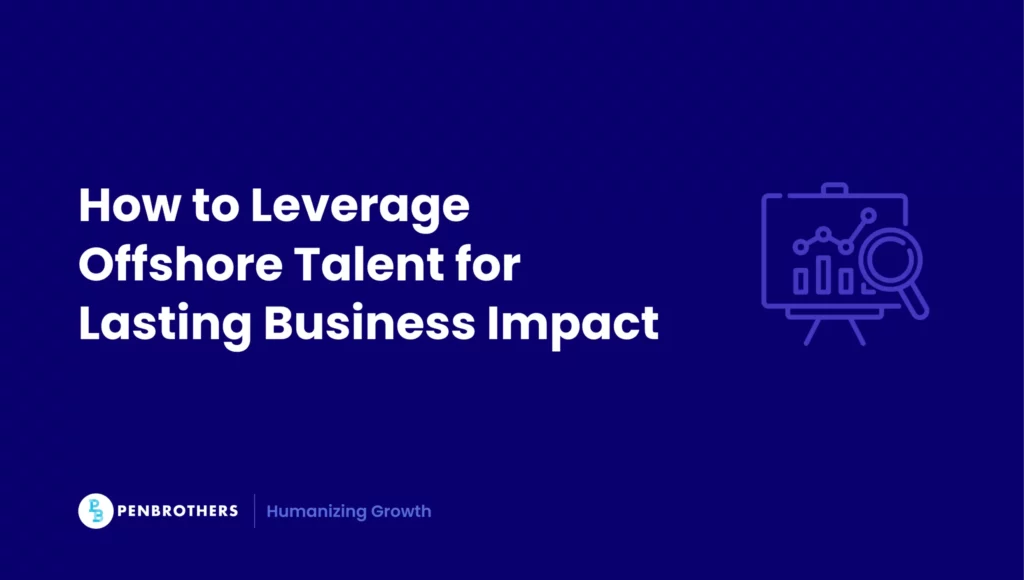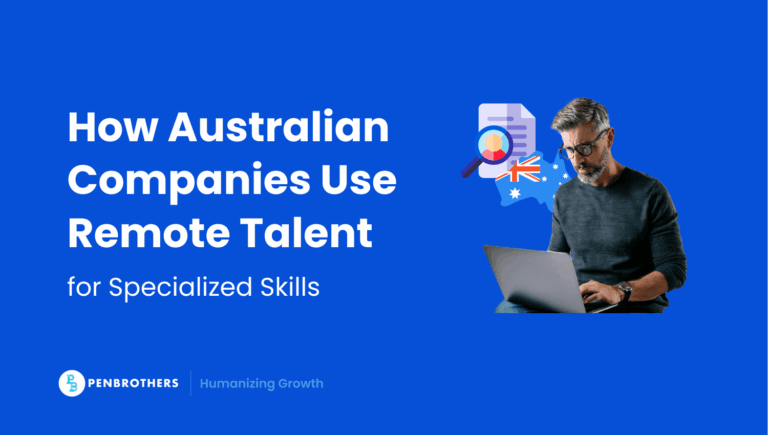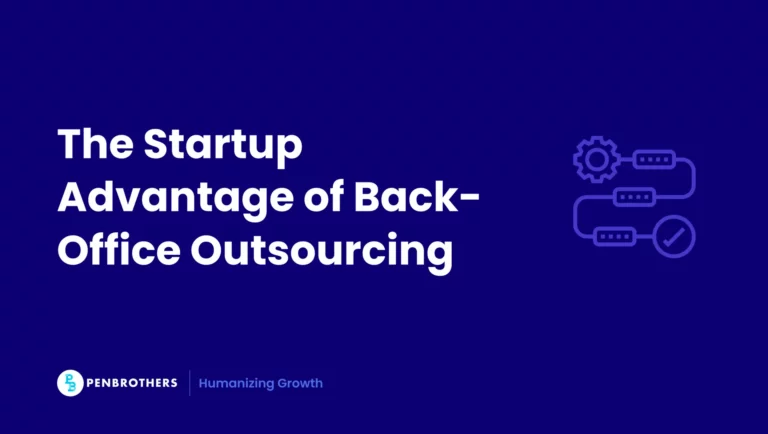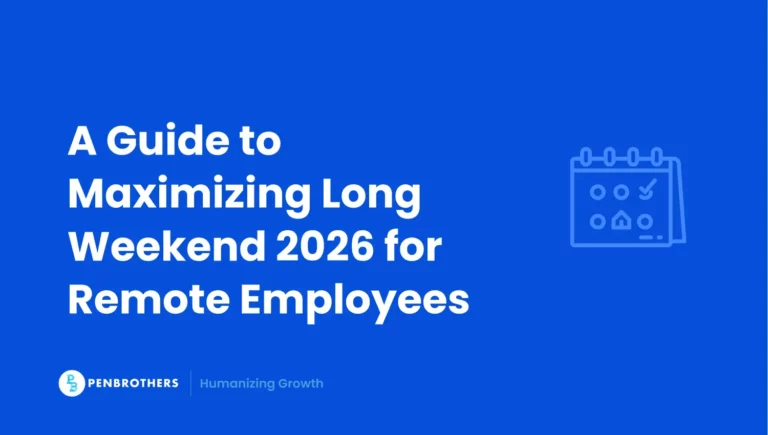Key Takeaways
- A Strategic System for Accessing Global Talent: A modern remote staffing agency is not just a recruiter; it provides the entire infrastructure for building a global team. This includes sourcing talent, providing the legal framework (EOR) for compliant hiring, and handling all operational support like payroll and HR.
- The Real Drivers are Speed, Access, and Scalability: While cost savings of 60-70% are a major benefit, the key strategic drivers for executives are speed-to-hire (reducing hiring time from months to weeks), access to scarce, specialized skills (like in tech and finance) that are unavailable locally, and the scalability to quickly ramp teams up or down without long-term overhead.
- The “90-Day Failure Trap” is the Biggest Risk: Most offshore hires who fail do so in the first three months, not because of a lack of skill, but due to poor onboarding, unclear expectations, and unmanaged cultural gaps. Success depends on a structured integration plan, not just a good hire.
- Partner Selection is About Systems, Not Just Price: When evaluating an agency, the most critical factors are the systems they have in place. Executives should look for a documented integration framework (like a 90 or 180-day plan), a transparent, all-in pricing model, and a rigorous vetting process that screens for cultural fit as well as technical skills.
Five years ago, hiring a software architect meant competing with twenty companies for the same five candidates in your city. Today, the best architect might be in Manila, building products for a Y Combinator startup while earning what feels like Silicon Valley money in the Philippine economy.
The shift happened quietly, then suddenly. Remote staffing agencies went from managing call centers to orchestrating entire product teams. Companies that understood this early now operate with labor costs slashed by up to 70%, dramatically lowering their burn rate and allowing them to ship faster than venture-backed competitors.
Here’s what changed: Geography stopped being a factor.
The Philippines produces hundreds of thousands of STEM-related graduates annually, most speaking world-class business English. Poland’s developers consistently rank at the top globally in technical assessments. Colombia’s tech sector saw explosive growth in recent years.
These regions become untapped talent pools that most companies don’t know how to access yet.
But the average executive still thinks offshore means offshore outsourcing: the old model where you’d throw requirements over a wall and hope something decent came back. That model is now obsolete.
Modern remote staffing agencies don’t merely provide discount labor. They provide infrastructure for accessing a global talent system. The companies using them aren’t cutting costs on mediocre developers. They’re securing world-class professionals who happen to live where $40,000 provides the lifestyle of $180,000.
So, the question isn’t whether to engage a remote staffing agency anymore. The question is whether you’ll figure out the system before your competition does.
What Is a Remote Staffing Agency?
Traditional staffing agencies fill seats in your office. Remote staffing agencies provide the entire system for building teams across borders: the talent, the legal framework, the operational support. They specialize in identifying, vetting, and managing full-time professionals who work exclusively for you from another country.
The business models break down into three categories:
Staff augmentation adds specific expertise to your existing team. Need a React developer asap? They find one, handle the contracts, manage the compliance.
Dedicated teams mean building entire departments offshore. Your customer success team might be entirely Philippine-based, managed locally but reporting to you.
Managed services take it further. The agency delivers outcomes, not just people. They handle both the talent and the processes to achieve specific business goals.
The biggest misconception? That these agencies are body shops selling discount labor. Modern remote staffing agencies function more like international HR departments. They provide Employer of Record (EOR) services, meaning they legally employ your team in their country while you manage the work. This removes the compliance nightmare of international hiring.
Why Executives Are Turning to Remote Staffing Agencies
The numbers make the initial case. Labor costs drop 60-70% when you hire through a Philippine-based remote staffing agency versus local US hiring. A senior developer who costs $180,000 in San Francisco might cost $40,000 in Manila. Same skills. Sometimes, superior dedication.
But cost is table stakes. The real drivers run deeper.
Speed changes everything. Traditional hiring takes 3-4 months from job posting to first day. Remote staffing agencies maintain pre-vetted talent pools. Time to hire drops to 3-4 weeks. In competitive markets, that acceleration determines who ships first.
Access to scarce skills becomes possible. Try finding a blockchain developer with healthcare experience in Dallas. Now expand your search to include Warsaw, Bangalore, and São Paulo. The talent pool multiplies by orders of magnitude.
Scalability without commitment transforms planning. Need to double your customer support for the holiday season? Scale up in October, scale down in January. No severance packages. No unused office space. No long-term overhead.
The 2024 data backs this up. Remote workplace services are growing at 23.8% CAGR, reaching $58.5 billion by 2027. Meanwhile, traditional staffing actually declined 10% in the US in 2023 despite strong GDP growth. Companies aren’t hiring less. They’re hiring differently.
When to Use a Remote Staffing Agency
High-value scenarios make the decision obvious.
After funding rounds, when you need to scale fast but preserve runway. Every dollar saved on salaries extends your timeline. Every week saved on hiring accelerates your product roadmap.
Entering new markets where local hiring would take months to establish. Launch customer support in Australia using Philippine-based teams who work Australian hours. Test the market without fixed infrastructure costs.
Filling niche technical roles that barely exist in your local market. Machine learning engineers with fintech experience. DevOps specialists who understand healthcare compliance. The more specific your needs, the more global your search must be.
But remote staffing isn’t always the answer.
While this strategy can be applied to almost any role, analysis of the current market shows high demand across several key industries:
- IT and Technical Services: (Software Development, DevOps, QA, IT Support)
- Finance and Accounting: (Bookkeeping, Financial Analysis, Accounts Payable)
- Sales and Customer Support: (Customer Service, Technical Support, Sales Development)
- Marketing and Creative Services: (Digital Marketing, Graphic Design, Content)
- Administrative and Operations: (Virtual Assistants, Project Management, HR)
Red flags include: roles requiring physical presence, positions needing local licenses or certifications, and jobs where real-time collaboration is non-negotiable and time zones don’t align. A surgeon can’t operate remotely. A lawyer needs local bar admission. A creative director might need to be in every brainstorm.
Here’s a perfect example of a successful remote staffing decision:
When luxury fashion resale platform Luxclusif needed to scale during its bootstrapping stage, it turned to Penbrothers to build a high-performing team in the Philippines. We sourced, hired, and managed logistics, finance, and technical talent, handling all compliance, payroll, and HR tasks. The result: average savings of 78% per role, rapid operational scaling, and a path to profitability that ultimately led to Luxclusif’s acquisition by Farfetch Group in 2021.
Common Remote Staffing Pitfalls (and How to Avoid Them)
The three-month failure trap is real. Most offshore hires who fail do so in the first 90 days. Not because they lack skills, but because the system failed them.
Poor onboarding kills momentum. Sending a laptop and a Slack invite isn’t onboarding. Remote employees need structured integration: clear expectations, cultural immersion, and systematic support. Without it, isolation leads to disengagement.
Unclear expectations create confusion. “Figure it out” doesn’t work across cultures and time zones. Remote teams need explicit goals, documented processes, and measurable outcomes. Ambiguity multiplies with distance.
Cultural gaps widen without bridges. A developer in Kraków processes feedback differently from one in Kansas. Filipino professionals often won’t directly challenge ideas even when they disagree. These aren’t weaknesses. They’re differences that need proper guidance.
Generic vendor selection guarantees mediocrity. Choosing the cheapest agency or the one with the glossiest website misses the point. You need partners with proven frameworks, compliance expertise, and cultural bridging capabilities.
Executive checklist for due diligence:
- Placement success rate (should exceed 90%)
- Full EOR services (not just payroll)
- Structured onboarding framework
- Compliance expertise in your target countries
- Transparent total cost structure
- Client references with measurable outcomes
How a Remote Staffing Agency Works: Step-by-Step Process
Understanding the process helps you engage effectively.
Needs assessment and role definition come first. The agency should challenge your assumptions. Do you really need a senior developer, or would a mid-level developer with specific experience work better? This is where executives must be directly involved, because nobody else can define what success looks like for your business.
Candidate sourcing and vetting are next. Good agencies maintain talent pools and active pipelines. They should present 3-5 qualified candidates within 30 days, pre-screened for technical skills, communication ability, and cultural fit. You make the final decision, but they eliminate the noise.
Onboarding and integration determine success or failure. The agency should provide structured frameworks: equipment setup, account creation, cultural orientation, team introductions. You own the role-specific training, but they handle the infrastructure.
Ongoing management and performance monitoring continue throughout the engagement. The agency manages compliance, payroll, and HR issues. You manage the work. Regular check-ins identify problems before they become failures.
Executives should be hands-on during role definition and final candidate selection. Delegate the sourcing, vetting, and administrative management. Stay involved in performance reviews and strategic decisions about team scaling.
Offshore Talent Hubs: How They Compare
Each region offers distinct advantages.
The Philippines dominates customer service and administrative support. As I mentioned above, English fluency is exceptional (it’s an official language). Cultural alignment with Western business practices runs deep. Average developer salary: $20,000-$45,000+ annually. Customer service: $9,6000-$12,000+ annually. Time zone challenges exist for US companies, but the BPO industry runs 24/7.
See our Salary Guide 2025 for a full list of salary ranges.
India provides unmatched scale for technical roles. The talent pool is massive: millions of developers. Technical education is world-class. Average developer salary: $12,000-$20,000. Communication can require more management attention. Time zones work better for European companies.
Eastern Europe (Poland, Romania) produces exceptional senior developers. Technical skills rival Silicon Valley. Strong engineering education systems. Average senior developer salary: $55,000-$70,000+ annually. Significant time zone overlap with Western Europe, manageable with the US East Coast.
Latin America (Mexico, Brazil, Argentina) offers proximity advantages for US companies. Time zones align perfectly. Cultural similarities reduce friction. Growing tech sectors. Average senior developer salary: $45,000-$75,000+ annually. English proficiency varies more than in other regions.
Why the Philippines stands out for most SMEs: the combination of English fluency, service orientation, and cost-effectiveness is unmatched. A customer success team in Manila costs 70% less than in Austin while often delivering better customer satisfaction scores.
How to Evaluate the Best Agencies for Remote Staffing
A Google search for “remote staffing agencies” is overwhelming. The best partners are differentiated not by their marketing, but by their systems. Executives should evaluate potential agencies on three non-negotiable criteria.
1. A Documented Integration Framework
The greatest risk is not a bad hire; it’s the 90-day failure trap caused by poor integration. Vague promises of “support” are a red flag.
Ask for their specific, documented onboarding plan. For example, our Hypercare Framework is a 180-day, milestone-driven process. It moves a new hire from Integration (Day 1-30) to Performance Alignment (Day 30-90) and finally to Autonomy and Retention (Day 90-180). This system is designed to identify and fix misalignments early, which is why we maintain a 92% retention rate after one year.
2. Transparent, All-In Pricing
Many agencies hide costs in complex fees. Demand a clear, itemized cost structure before you engage.
The price should be simple: the staff member’s compensation plus a fixed monthly management fee. This all-in model avoids surprises and aligns the agency’s success with your own. When an agency provides transparent salary benchmarks and a clear total cost from the first discovery call, it signals a partnership, not a transaction.
3. Rigorous Vetting for Tech and Specialized Roles
To answer “how tech staffing agencies handle remote it placements,” you must look past the résumé. A good agency’s vetting process is a filter, not a database.
Our process, for instance, screens hundreds of applicants down to the top 1-2% before they ever reach your desk. For technical roles, this includes:
- Skills and Technical Assessments to validate expertise.
- Language and Communication Screening to ensure cultural and team fit.
- Reliability and Culture Checks to find long-term, committed professionals.
An agency that can’t articulate its vetting funnel is just a résumé service. A true partner delivers talent that is ready to contribute from day one.
The Hypercare Framework: Turning Offshore Hiring Into a Competitive Advantage
Most offshore teams that fail do so in the first six months, not because of talent, but because there is no system to ensure their success.
Penbrothers’ 180-day Hypercare Framework is the proven system designed to address this directly. It’s not just a 30-day check-in; it’s a structured journey that slashes failure risk and accelerates productivity.
The framework is divided into three distinct phases:
- Phase 01: Integration (Day 1-30). This initial stage is foundational. We move beyond basic setup to focus on clear role expectations, cultural alignment, and team integration to ensure new hires are productive from day one.
- Phase 02: Performance Alignment (Day 30-90). Once integrated, we focus on consistency and reliability. Through bi-weekly reviews and early gap detection, we refine workflows and resolve misalignments before they become problems.
- Phase 03: Autonomy and Retention (Day 90-180). The final stage guides your hire toward true independence and an ownership mindset. We establish long-term goals and career growth paths , fostering the engagement that leads to long-term commitment.
This proactive, 180-day system delivers measurable results: 92% retention after one year and 80% of misalignments resolved early. And if a hire doesn’t work out within the guarantee period, we replace them free of charge.
That’s what differentiates Penbrothers from most remote staffing agencies, and it’s exactly why companies like DesignCrowd trust us to power their growth.
When Australian design marketplace DesignCrowd decided to expand in the Philippines, they needed more than just talent; they needed a partner who could manage HR operations, payroll, compliance, and provide a workspace where teams could thrive. Penbrothers delivered all of that, sourcing high-quality candidates who grew with the company and eventually took on more complex roles in customer service, finance, and marketing. The results: an average cost saving of 78% per role, seamless legal compliance, and a motivated team that enabled DesignCrowd to scale quickly without sacrificing quality.
From Skepticism to Strategic Partner
So, the evidence is clear. Companies using remote staffing agencies strategically scale faster, burn less cash, and access expertise their competitors can’t afford.
Success doesn’t come from finding cheap labor. It comes from partnering with agencies that provide infrastructure, compliance, and frameworks for making global teams work. And the difference between failure and success isn’t the talent you hire. It’s the system you use to integrate them.
Plus, the right remote staffing agency transforms offshore hiring from risk to advantage. They handle the complexity so you can focus on the work. They provide the structure that turns geographic distribution into competitive differentiation.
If your growth is being held back by talent bottlenecks, the right remote staffing partner can remove those limits. Our Hypercare Framework ensures your offshore teams deliver from day one—and stay that way.
Contact Penbrothers to explore what that looks like for your business.
Frequently Asked Questions
A traditional staffing agency typically fills temporary or permanent roles in your local office. A remote staffing agency specializes in building dedicated, full-time teams in other countries, providing a complete system that includes talent sourcing, legal compliance, payroll, and HR support.
An Employer of Record (EOR) is a service provided by most modern remote staffing agencies. The agency acts as the legal employer for your team members in their home country, handling all local contracts, payroll, taxes, and labor law compliance. This removes the legal and administrative complexity of international hiring from your company.
Beyond the significant cost savings (60-70%), the primary reasons are speed (hiring in 3-4 weeks instead of 3-4 months), access to specialized skills that are scarce in your local market, and the scalability to grow or shrink your team quickly without the financial commitment of permanent local hires.
They typically fail due to a breakdown in the system, not a lack of talent. The most common reasons are poor onboarding (just sending a laptop and a login), unclear expectations from a manager, and unaddressed cultural differences in communication and feedback styles, which lead to isolation and disengagement.
Each region has different strengths:
The Philippines: Dominates in customer service, administrative, and creative roles due to exceptional English fluency and cultural alignment, with very high cost-effectiveness.
India: Offers unmatched scale for technical and IT roles, with a massive talent pool of developers.
Eastern Europe: Is known for exceptional, high-quality senior developers, but at a higher price point.
Latin America: Is the top choice for nearshoring from the U.S., as it offers perfect time zone alignment and strong cultural similarity.






